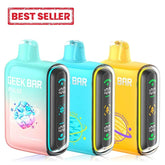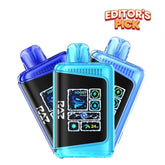Puff Bar Punches Back
Most of us remember Puff Bar, and their troubles barely a year ago. But it looks like they aren't tucking their tails and running away, like everyone had initially thought.
For those who don't recall, Puff Bar had their sales boosted in early 2020 when flavored e-juice refill pods were taken off the market; because Puff Bar's disposables weren't technically refillable, the bans didn't apply to them. Anti-tobacco groups and the US government called for a ban on Puff Bar, when the FDA started cracking down on underage vaping. Puff Bar proactively declared that they would stop their US sales, and in July of 2020, the FDA ordered them to halt sales completely, which they did. Puff Bar has been relatively quiet ever since.
__________________________________________________________
Bonus Article: Most Popular Disposable Vape Brands
__________________________________________________________
But now, Puff Bar appears to be back, and they've introduced a change which may allow it to get around the FDA's scrutiny: Puff Bar says it's using synthetic tobacco-free nicotine (known in some circles as "TF,") in their disposables now, which means it technically isn't a tobacco product anymore—even if it is still a nicotine product.
The FDA hasn't said yet if the Puff Bar ban is applicable now that they're using TF in their products; but if it turns out that this loophole can stand, then synthetic nicotine may just be a game-changer. Companies like Juul (who were also hit hard during the flavored juice witch hunt of early 2020,) may now have the tool they need to fight back against regulations that have crippled their sales over the past year.
Some people are less than thrilled with Puff Bar, and their products, in regard to underage kids vaping. Mitch Zeller, director of the FDA’s Center for Tobacco Products, has even said: “We are very concerned about how popular these products are with youth. The FDA is keeping a close watch on the marketplace and will hold accountable those companies that violate tobacco laws and regulations.” The question now is, if synthetic nicotine can be used without depending on tobacco, do those laws and regulations even apply?
The inclusion of tobacco has never been the issue when it came to flavored e-liquid anyway; tobacco-flavored juices were actually some of the least-preferred juices before the flavor ban came into play. It's absolutely not a coincidence that the Tobacco Lobby has had it in for flavored juices ever since delicious flavor alternatives started out-selling tobacco-flavored juices. One doesn't really have to think hard to figure out why the tobacco-flavored juices, (with the full force of the Tobacco Lobby behind them,) only seemed interested in stopping the sale of non-tobacco flavored juices; and now, tobacco-flavored juices are the only real exceptions to the flavored juice bans which have been unfairly slapped down in some areas of the United States.
TF may be the way to get around the bans laid down by the FDA, and beat the Tobacco Lobby at their own game of technicalities. Once Synthetic Nicotine can be used, widespread, to infuse juices with nicotine without using tobacco, we may just see another rise in flavored juice purchases, and strike another blow against the Tobacco Lobby's biased, greed-fueled agenda.
Regulation may still need to happen, even if TF becomes a regular thing in vaping products. According to The Wall Street Journal, an FDA spokeswoman said that an e-cigarette containing synthetic nicotine might still have components or parts of a tobacco product, and thus be subject to FDA’s tobacco regulations. Alternately, if it doesn't have those components, a synthetic nicotine e-cigarette might fall under the jurisdiction of the FDA’s Center for Drug Evaluation and Research instead; which regulates smoking cessation products like nicotine gum, and other tools consumers use to help them quit smoking cigarettes.
People frequently use vaping as a tool to kick cigarettes. Many people over the years have said that vaping "saved their lives," when it came to trying to quit a difficult habit to break. With TF being used in these products instead of tobacco-derived nicotine, people might just get access to the better-tasting disposable vape devices they feel they need in order to quit. They can still get the nicotine they're hooked on in TF form, and do what most vapers trying to quit cigarettes do—graduate to lower and lower nicotine levels, until they can quit nicotine completely.
The future isn't certain for TF yet, but if synthetic nicotine can help get the vape industry out from under the oppressive thumb of the tobacco lobby, and allows flavored vape to help people who want to quit actually enjoy quitting, TF could be the great innovation that the industry desperately needs in order to keep its head above water, in a sea of overwhelming legislations.














